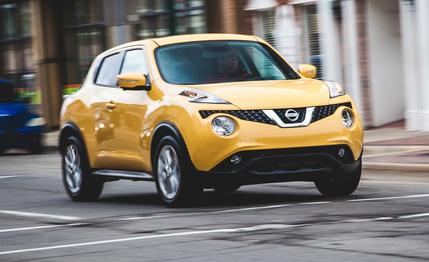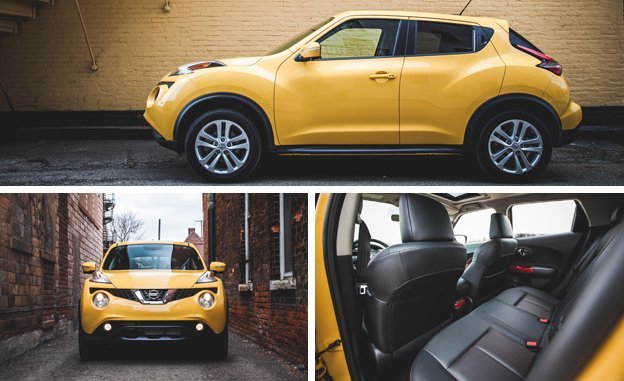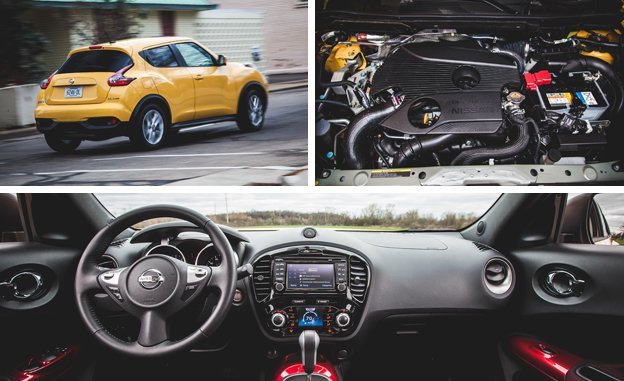 Instrumented Test
Instrumented Test
Quirky. Offbeat. Funky. It seems wherever Nissan’s Juke goes, those three adjectives seem to follow. And we get it: A subcompact crossover, the Juke wears its high wheel arches and an even higher beltline as badges of nonconformist honor, their effect only amplified by the slivers of side glass, ambiguous rear doors, bulbous tailgate, and twisted front and rear lamp lenses that rise, blisterlike, from the body surface. But to write off the Juke as a cheap carnival trick on wheels would be a disservice.
If you’re looking for an indication of how seriously Nissan takes the Juke, you’ll find it in the comprehensive round of revisions its engineers performed on the 1.6-liter inline-four for 2015: The pistons are reshaped, the compression ratio is increased (now 10.5:1, up from 9.5:1), internal friction and engine weight have been reduced by switching from iron liners to “spray-coated and mirror-finish cylinder bores,” and turbocharger inertia is lower. There’s more. Nissan also added a new intermediate lock function on the intake side of the Continuously Variable Valve Timing Control System, fitted a low-pressure EGR system to lower exhaust-gas temperature, switched to a variable-pressure oil pump, and optimized injector performance. This was definitely more than just a tuning tweak.

Despite the significant hardware updates, the second-gen 1.6-liter turbo four produces the exact same 188 horsepower and 177 lb-ft of torque as the previous version. The good news is that peak torque is now available at 1600 rpm, whereas the previous setup didn’t get its full grunt until 2000 rpm. It’s still a little buzzy but noticeably less so than before. Nissan maintains that additional benefits are lower emissions and better fuel efficiency, the latter evidenced by a 1-mpg improvement in both city and highway mileage ratings, which now stand at 26 and 31 mpg. We recorded 26 mpg in combined driving.
Paired with the CVT as its sole dance partner (two-wheel-drive Jukes could be had with a six-speed manual through the 2014 model year), our all-wheel-drive Juke SL’s powertrain was well suited to propelling the 3205-pound hatchback. With zero-to-60 and quarter-mile times of 6.9 and 15.4 seconds, it easily out-accelerates competitors such as the 2015 Jeep Renegade 4x4 with the 180-hp 2.4-liter four and nine-speed automatic (8.8 and 16.8), and the 2016 Honda HR-V AWD with a 1.8-liter four and CVT (9.5 and 17.4). Nissan’s Integrated Control (I-CON) system provides Normal, Sport, and Eco drive modes, which tailor throttle, steering, and transmission response. It goes without saying which setting we favored.
Segment-leading acceleration aside, this is not the type of powertrain that inspires deep analysis or critique; despite Nissan’s inclusion of gearlike “steps” in the CVT, we found the easiest way to get the most smiles per mile was to simply put the transmission in drive, select Sport mode, and mash the accelerator. (Not to mention the fact that we noted a “slipping” feeling in the CVT when manually shifting at 6250 rpm.) All 177 lb-ft of torque is available from 1600 to 5200 rpm, which helps to take the drama out of merging maneuvers. Conversely, the CVT isn’t shy about letting the engine wind up and mingle with the 6400-rpm redline. With the AWD system varying the amount of torque sent fore and aft up to a 50/50 split, traction is abundant.
Equipped with 17-inch 215/55 Goodyear Eagle RS-A tires, our Juke managed a lateral-acceleration figure of 0.84 g on our 300-foot skidpad, handily beating the aforementioned Renegade’s 0.78 g number and the 0.80 g recorded by the all-wheel-drive Honda HR-V. Speed-sensitive electric power steering gets the job done with good directional accuracy, but its synthetic feel is uninspiring. Still, the smallish 99.6-inch wheelbase and rear-axle torque vectoring—which increases the amount of torque sent to the outside rear wheel in hard cornering—add to the Juke’s already nimble behavior. Tromping on the brake pedal revealed firm and easily modulated braking action. Hauling the Juke down to a stop from 70 mph required 177 feet of tarmac.

Even though this Nissan is ostensibly a five-passenger vehicle, we found it hard in most circumstances to squeeze even two people into the back seat. While it’s quite possible for a pair of long-limbed individuals to get comfortably situated in front, sliding the front seats rearward renders the rear seat essentially unusable. We found it much preferable to fold the rear seatbacks forward, increasing the diminutive, 10.5 cubic feet of cargo room to a slightly less-diminutive 35.9 cubic feet, creating a quasi–shooting brake of sorts. In this configuration, the Juke displays a modicum of genuine utility.
Those still not convinced that the Juke has a sober side need only consider its $27,765 base MSRP. After tacking on floor mats and a cargo mat ($210) plus a center armrest ($250), our Juke SL AWD rang in at a cool $28,225. That number rubs shoulders with vehicles like the Honda CR-V EX AWD (base price $27,675) and the Mazda CX-5 AWD Touring ($27,345), two vehicles with a tad less attitude but a lot more interior space. But for those extroverts who desire a tenacious turbo engine in a tiny AWD crossover, the Juke is serious business.